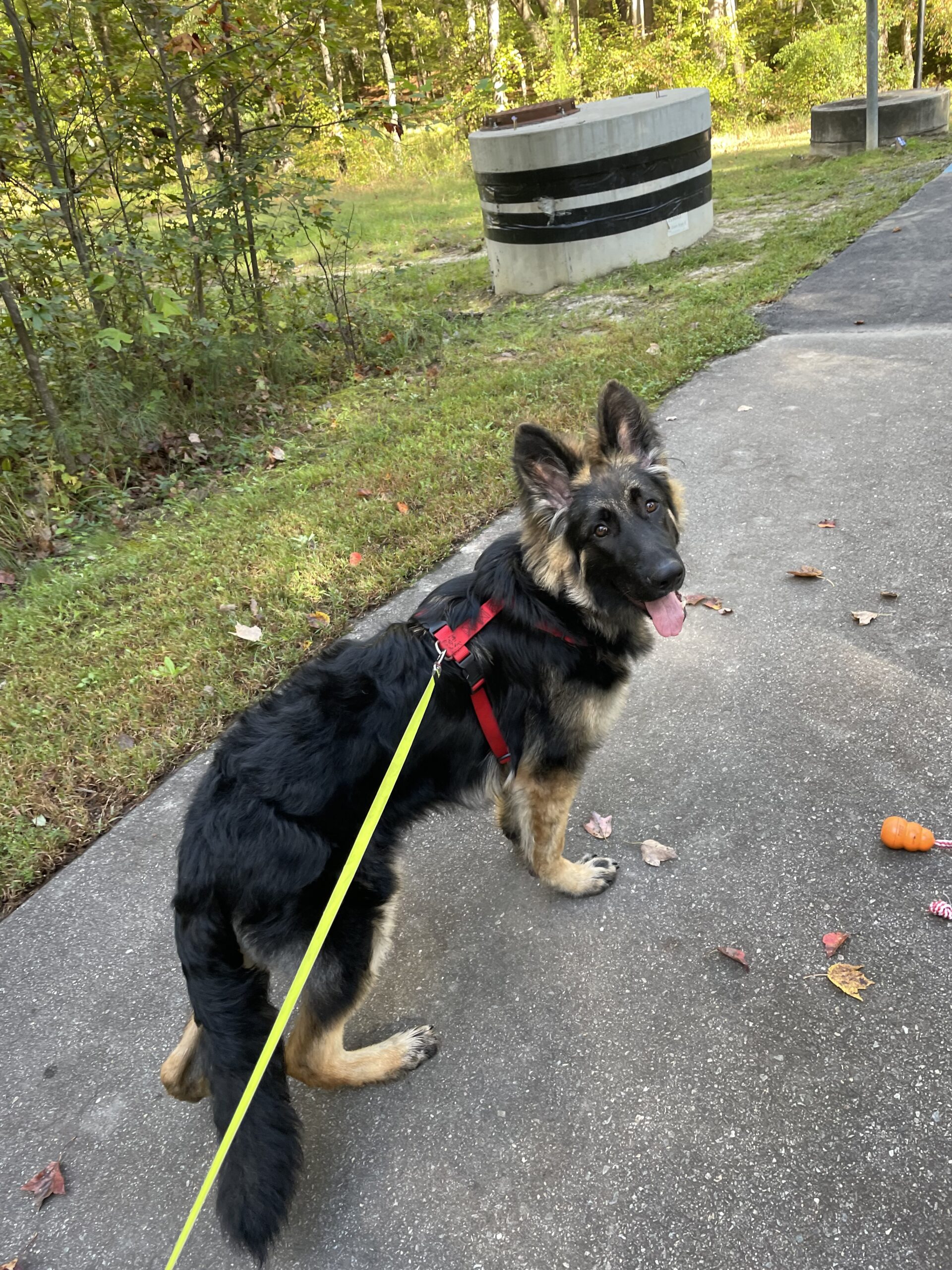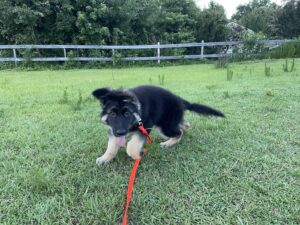Leashes are a fact of life for our dogs. But that doesn’t mean that our dogs come pre-installed with the knowledge of how to respond to the leash tightening.
Leashes can contribute to a lot of frustration in some dogs, especially if your dog doesn’t understand how to respond to leash pressure. Putting pressure on your dog’s leash is inherently uncomfortable, even if your dog is wearing a comfortably fitted non-restrictive harness. This discomfort can affect some dogs more than others, especially if they have assistive or corrective training equipment (like front clip harnesses, or prong, slip, or head collars).
The best thing we can do for our dogs is to provide clarity about what leash pressure means, and how to turn it off. We can even turn leash pressure into a game!
PS: Scroll to the bottom or click here to see a video of a dog learning the leash game.
How To Play the Leash Game
Things you’ll need: your dog, a collar or harness, their leash, some treats, a space with no distractions and enough room to move around.
-
- Get your dog ready to work. Once they’re ready, toss a cookie on the ground for them to eat.
- As soon as they eat the cookie, apply gentle pressure to the leash – just enough to feel!
- As soon as they look to you or step towards you, mark and reward them with praise and food.
- Repeat.
Troubleshooting: If they don’t look to you after a moment, call their name, take a step away from them, make a kissy sound, etc.
As your dog gets good at the leash cue game, gradually level-up and increase the difficulty one step at a time. Start practicing in environments with gradually increasing levels of distraction.
Here is how you can introduce distraction with the Leash Game:
-
- Use a low-level distraction you know your dog can work around.
- After your dog engages with the distraction, apply light pressure to their leash.
- Wait one second, then call your dog’s name and take a step away from them.
- As soon as they disengage from the distraction and look to you or move in your direction, mark and reward.
- Repeat.
Light pressure means they can feel the leash lift, and they might feel pressure on their collar or harness, but it should not pull them. Do not yank or drag your dog. This is a game for turning the leash into a positive or neutral stimulus, not sensitizing it as a punishment or aversive stimulus.
Once your dog is really good at the leash game, you can start to use it in situations where the leash has added conflict or stress.
Here is how you can introduce a high-level distraction with the Leash Game for a dog with leash reactivity.
-
- At a distance where your dog is engaged with the trigger but is not actively attempting to move towards it, apply light leash pressure.
- As soon as they disengage from the distraction, mark and jackpot!
- They do not have to engage with you, just disengage from the trigger!
- Immediately increase distance from the trigger until your dog is once again below threshold.
- Do not repeat.
In this case, the leash is both the announcement that the interaction has ended, and a cue that a jackpot is available if you can disengage. Avoid repeating this exercise during the learning phase if at all possible, because that negates the underlying premise. In this case, we are using the leash to de-escalate the situation. Revisiting the trigger immediately risks turning the leash into something that escalates instead of de-escalates.
Troubleshooting
- My dog won’t look at me when I add pressure to the leash, and we aren’t even working around distractions.
- Try taking the leash off, and playing a few rounds of Ping-Pong or Up-Down. Toss a treat for your dog to chase. After they eat it wait for them to look at you. The moment they look at you, mark “Yes, get it!” and toss another one. Repeat a handful of times.
- Try again! Add the leash, and be ready to add that gentle pressure right after they eat the treat.
- Every time I toss the treat, it goes too far and my dog hits the end of the leash.
- Adjust your treats, your environment, or your leash!
-
- Less bouncy treats can be more precisely thrown. Practice a few rounds without a leash to get good at your placement.
- A grass, dirt, or other natural environment can reduce bouncing. Try it in a new location.
- A flexi-leash is a fabulous tool for games like this. Don’t toss too far, but this can simplify things!
-
- Adjust your treats, your environment, or your leash!
- My dog is way faster than me! They look at me before I can even apply pressure.
- Try skipping the treat tossing, and working around a very low-level distraction. Remember, we want them to be able to disengage easily and quickly.
- If you’re working around distractions and your dog is paying too much attention to you, try increasing the level of distraction or using a lower-value treat.



